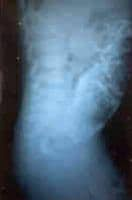Hirschsprung disease is a developmental disorder of the enteric nervous system and is characterized by an absence of ganglion cells in the distal colon resulting in a functional obstruction.[1] See the image below.
 Hirschsprung disease. Contrast enema demonstrating transition zone in the rectosigmoid region.
Hirschsprung disease. Contrast enema demonstrating transition zone in the rectosigmoid region.
Although this condition was described by Ruysch in 1691 and popularized by Hirschsprung in 1886, the pathophysiology was not clearly determined until the middle of the 20th century, when Whitehouse and Kernohan described the aganglionosis of the distal intestine as the cause of obstruction in their series of patients.[2]
In 1949, Swenson described the first consistent definitive procedure for Hirschsprung disease, rectosigmoidectomy with coloanal anastomosis. Since then, other operations have been described, including the Duhamel and Soave techniques. More recently, advances in surgical technique, including minimally invasive procedures, and earlier diagnosis have resulted in decreased morbidity and mortality for patients with Hirschsprung disease.
Most cases of Hirschsprung disease are now diagnosed in the newborn period. Hirschsprung disease should be considered in any newborn who fails to pass meconium within 24-48 hours after birth. Although contrast enema is useful in establishing the diagnosis, full-thickness rectal biopsy remains the criterion standard. Once the diagnosis is confirmed, the basic treatment is to remove the poorly functioning aganglionic bowel and to create an anastomosis to the distal rectum with the healthy innervated bowel (with or without an initial diversion).
 Hirschsprung disease. Contrast enema demonstrating transition zone in the rectosigmoid region.
Hirschsprung disease. Contrast enema demonstrating transition zone in the rectosigmoid region. Although this condition was described by Ruysch in 1691 and popularized by Hirschsprung in 1886, the pathophysiology was not clearly determined until the middle of the 20th century, when Whitehouse and Kernohan described the aganglionosis of the distal intestine as the cause of obstruction in their series of patients.[2]
In 1949, Swenson described the first consistent definitive procedure for Hirschsprung disease, rectosigmoidectomy with coloanal anastomosis. Since then, other operations have been described, including the Duhamel and Soave techniques. More recently, advances in surgical technique, including minimally invasive procedures, and earlier diagnosis have resulted in decreased morbidity and mortality for patients with Hirschsprung disease.
Most cases of Hirschsprung disease are now diagnosed in the newborn period. Hirschsprung disease should be considered in any newborn who fails to pass meconium within 24-48 hours after birth. Although contrast enema is useful in establishing the diagnosis, full-thickness rectal biopsy remains the criterion standard. Once the diagnosis is confirmed, the basic treatment is to remove the poorly functioning aganglionic bowel and to create an anastomosis to the distal rectum with the healthy innervated bowel (with or without an initial diversion).
ليست هناك تعليقات:
إرسال تعليق